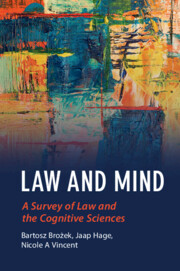Book contents
- Law and Mind
- Law and the Cognitive Sciences
- Law and Mind
- Copyright page
- Contents
- Figures
- Contributors
- Acknowledgements
- 1 Introduction
- I Metatheory and Methodology
- II Ontology and Epistemology
- III Legal Doctrine and Cognitive Sciences
- IV Evidence
- 17 Implications of Neurotechnology: Brain Recording and Intervention
- 18 Neuroimaging Evidence in US Courts
- 19 Neuroscientific Evidence in Context
- 20 Some Issues in Interpreting Neuroscientific Evidence
- 21 Explanation-Based Approaches to Reasoning about Evidence and Proof in Criminal Trials
- V Dissenting Opinions
- References
17 - Implications of Neurotechnology: Brain Recording and Intervention
from IV - Evidence
Published online by Cambridge University Press: 21 April 2021
- Law and Mind
- Law and the Cognitive Sciences
- Law and Mind
- Copyright page
- Contents
- Figures
- Contributors
- Acknowledgements
- 1 Introduction
- I Metatheory and Methodology
- II Ontology and Epistemology
- III Legal Doctrine and Cognitive Sciences
- IV Evidence
- 17 Implications of Neurotechnology: Brain Recording and Intervention
- 18 Neuroimaging Evidence in US Courts
- 19 Neuroscientific Evidence in Context
- 20 Some Issues in Interpreting Neuroscientific Evidence
- 21 Explanation-Based Approaches to Reasoning about Evidence and Proof in Criminal Trials
- V Dissenting Opinions
- References
Summary
Progress in cognitive neuroscience has led to the development of a variety of neurotechnologies that enable the recording and/or stimulation of brain processes. In this chapter the author examines various examples of neurotechnology, and indicates some of their potential effects on a user’s sense, and on society’s attribution, of agency, identity and responsibility. He focuses on neurotechnology that: (1) measures brain activity to drive applications in order to perform actions; (2) stimulates brains in order to change, restore or improve aspects of cognition; or (3) combines recording and stimulation to enable informational loops within or between brains.
- Type
- Chapter
- Information
- Law and MindA Survey of Law and the Cognitive Sciences, pp. 353 - 369Publisher: Cambridge University PressPrint publication year: 2021



